Physical Address
304 North Cardinal St.
Dorchester Center, MA 02124
Transurethral resection of the prostate (TURP)
Photo-selective vaporization of the prostate (PVP)
Holmium laser enucleation of the prostate (HoLEP)
Open simple prostatectomy
Transrectal prostate biopsy
Transperineal prostate biopsy
Radical prostatectomy (open/laparoscopic/robotic-assisted)
The prostate is a walnut-sized accessory male sexual organ composed of a mixture of glandular and fibromuscular tissue, located inferior to the bladder and directly above the superior fascia of the urogenital diaphragm. It lies within the pelvic cavity, below the lower part of the symphysis pubis and anterior to the rectum, through which it may be palpated. The primary function of this small gland is the production, secretion and storage of alkaline prostatic fluid. The fibromuscular component of the gland plays a pivotal role in bladder neck closure and semen propulsion during ejaculation.
Pathology of the prostate is extremely common: benign enlargement and malignant involvement both increase in prevalence with age. Consideration of the anatomical structure and relations of the gland is essential in the management of both of these conditions. This chapter contains an overview of the anatomy of the prostate and its relevance in the contemporary surgical procedures utilized in the management of benign prostatic hyperplasia (BPH) and prostate cancer.
The fetal genital system remains undifferentiated until the seventh week of embryogenesis, at which time the sex-determining region on the Y chromosome (SRY) induces a male phenotype through hormonal influences. In particular, the potent androgen, dihydrotestosterone, stimulates development of the fetal prostate and external genitalia. Towards the end of the first trimester, an outgrowth of epithelial buds from the posterior urogenital sinus epithelium into the surrounding urogenital sinus mesenchyme marks the preliminary event in prostate morphogenesis. Prostatic glandular epithelium develops from cells with endodermal origins, while the stroma and smooth muscle elements develop from cells of mesenchymal origin. Under the influence of androgenic hormones, the prostatic buds continue to multiply and form specific arrangements of epithelial cell cords within the mesenchyme, resulting in the lobar divisions of the prostate. The differing origins of the glands of the inner and outer regions of the prostate may account for the variations in incidence of prostate cancer. Acinar glands of the peripheral zone arise from the buds from the pelvic part of the urogenital sinus, while glands of the central and transition zones form from buds of the urogenital sinus above the level of the mesonephric ducts. In the male, the merging of the urinary and reproductive systems occurs in the prostatic part of the urethra, with implications for several surgical procedures.
The prostate is located entirely within the true pelvis, posterior to the inferior aspect of the pubic symphysis and anterior to the rectum (see Fig. 68.2B ). It can be assessed via anterior palpation during rectal examination, where the degree of enlargement and changes associated with malignancy, such as firm nodularity, loss of the median sulcus and extension of cancer into the seminal vesicles, can be appreciated. Although digital rectal examination is a rather unsophisticated and imprecise estimation of these parameters, it continues to play a role in the contemporary evaluation of the prostate for both size and malignancy.
The prostate is a pale, pyramidal fibromuscular gland surrounding the proximal male urethra. Superiorly, the flat base of the prostate is directed upward and is applied to the inferior surface of the bladder. The majority of the superior surface is directly continuous with the bladder wall. The urethra penetrates it closer to its anterior than its posterior aspect and typically traverses the gland along the junction of its anterior with its middle third. The apex is directed downward and is in contact with the superior fascia of the urogenital diaphragm, which invests the prostate and the membranous portion of the urethra and is intimately related to the external urethral sphincter.
The non-enlarged prostate measures approximately 4 cm transversely at its base, 2 cm in its anteroposterior diameter and 3 cm in its vertical diameter. It weighs 10–20 g and is supported by the superior fascia of the urogenital diaphragm, the puboprostatic ligaments and the anterior portions of levator ani.
The urethra and the ejaculatory ducts perforate the prostate. The ducts pass obliquely downward and forward through the posterior part of the gland and open into the prostatic portion of the urethra on the lateral aspects of the verumontanum (seminal colliculus), a rounded eminence of the urethral ridge on the floor of the prostatic urethra ( Fig. 73.1 ). The prostatic utricle, a small blind-ended pouch, opens into the midline of the seminal colliculus; numerous prostatic ducts drain into the prostatic sinuses that flank the colliculus. In clinical practice, the verumontanum is a crucial anatomical landmark because it indicates the proximal border of the striated external urinary sphincter during endoscopic procedures involving the prostate, and so marks the most distal limitation of intervention that will avoid surgical complications ( Fig. 73.2 ).
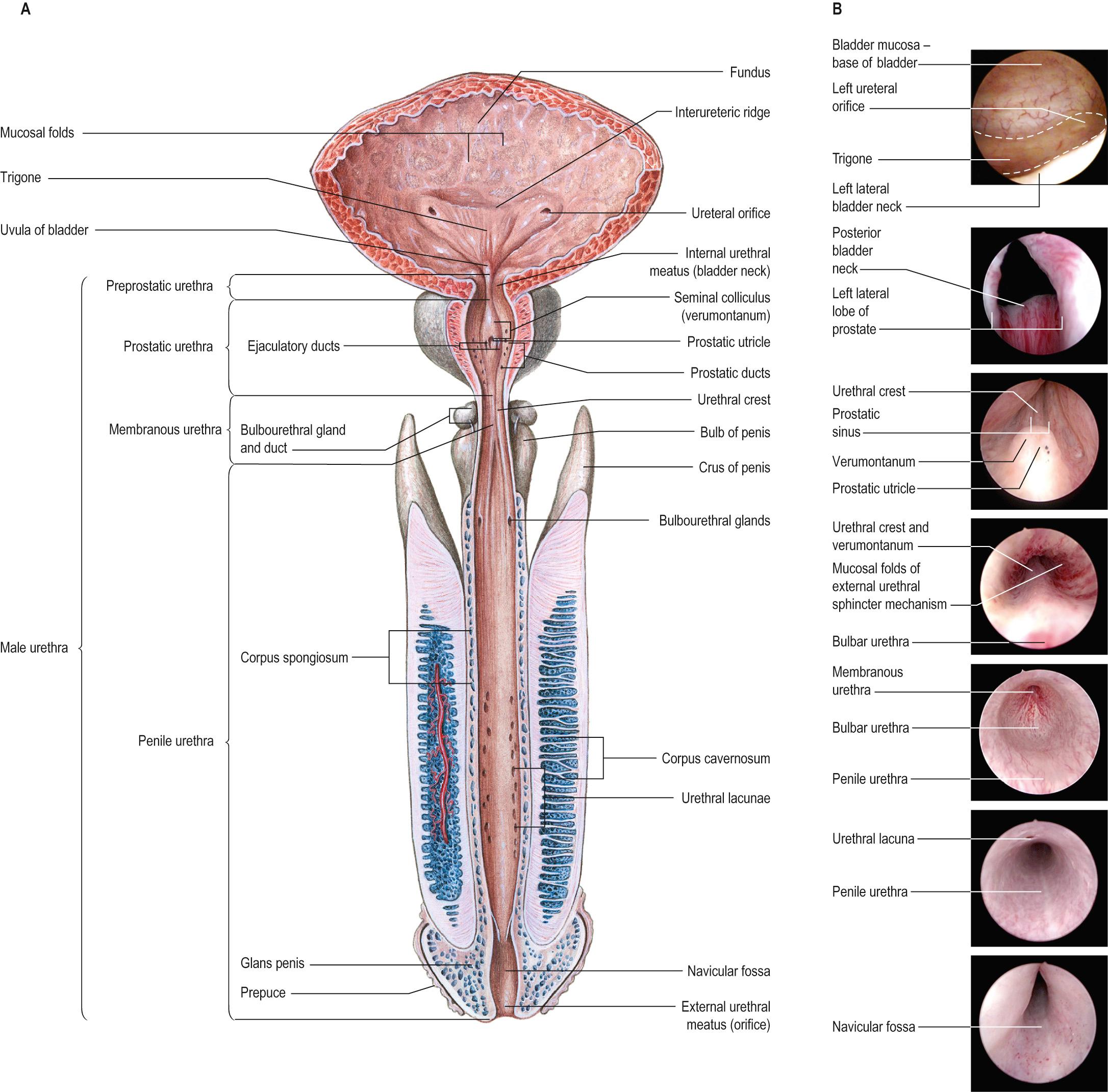
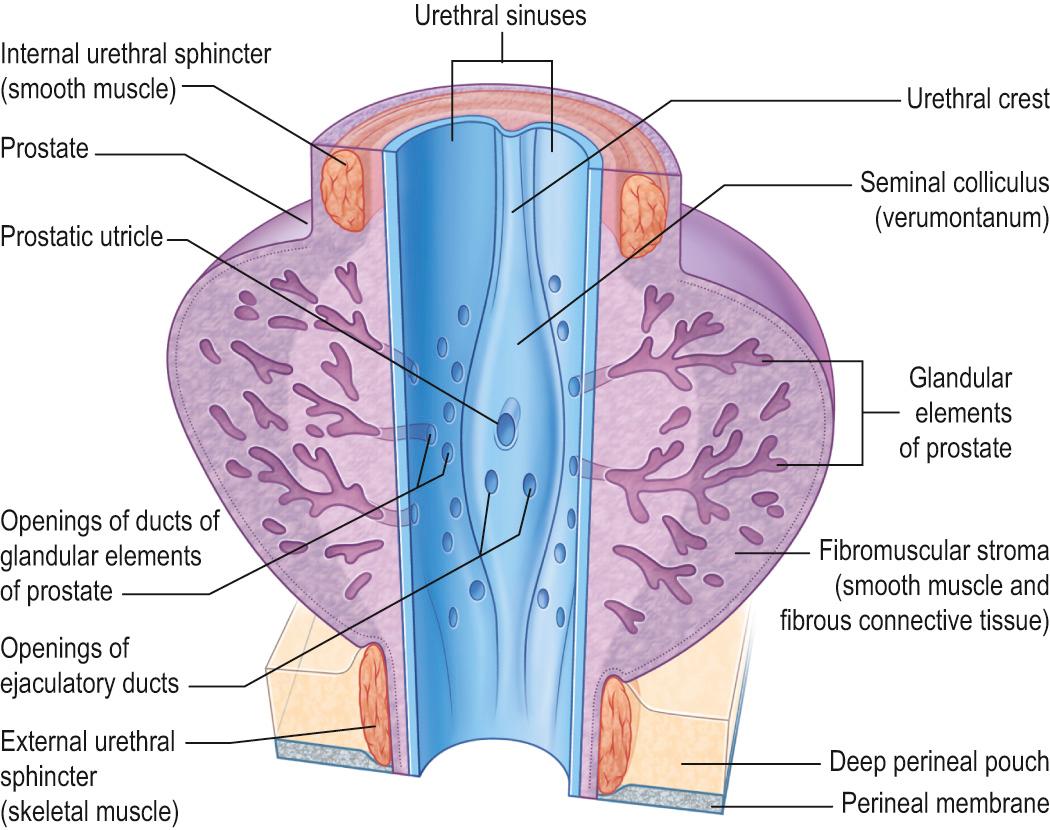
The prostate is surrounded by periprostatic fascia. The true capsule is a thin layer of connective tissue. The pseudocapsule is superficial to the anterior, posterior and lateral surfaces of the true capsule and consists of two fascial layers. The cavernosal nerves course between these layers, predominantly over the posterolateral aspect of the gland.
The posterior surface is flattened from side to side and is slightly convex from above downward. The two ejaculatory ducts enter the prostate at a medial depression near its upper border that serves to divide the posterior surface into a larger lower and a smaller upper portion. The latter constitutes the middle lobe of the prostate and intervenes between the ejaculatory ducts and the urethra; it varies considerably in size. The lower portion commonly features a shallow median depression or sulcus that imperfectly separates it into right and left lateral lobes, which constitute the main mass of the gland and are directly continuous with each other behind the urethra. Anterior to the urethra, the lateral lobes are connected by a band of fibromuscular stroma that is devoid of glandular substance. The rectoprostatic fascia, also known as Denonvilliers’ fascia, is a fibromuscular structure consisting of several fused layers that separate the retroprostatic and prerectal spaces ( Fig. 73.3 ). It inhibits the local invasion of prostate cancer posteriorly into the rectum and is a landmark during radical prostatectomy to gauge the proximity to the prostate for nerve sparing.
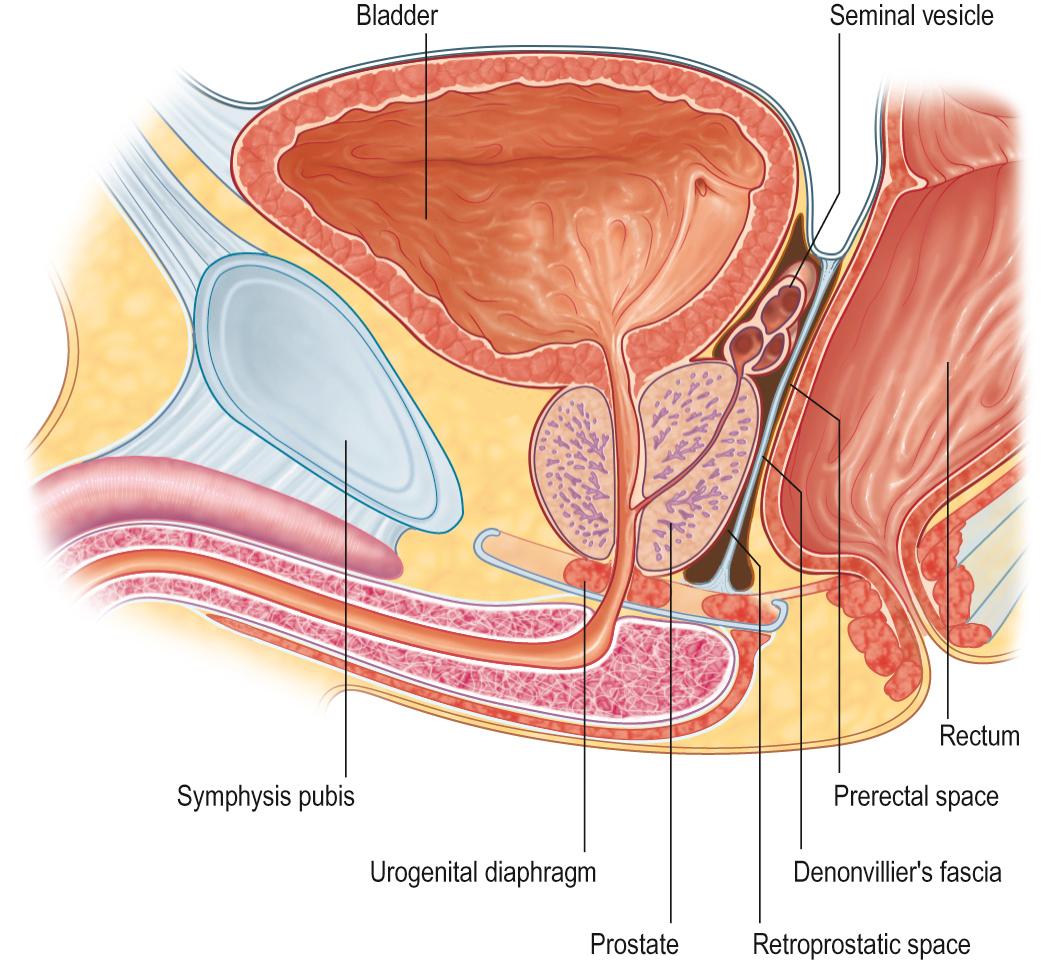
The anterior surface is narrow, measuring approximately 2.5 cm in craniocaudal length, and is convex from side to side. It lies 2 cm behind the inferior third of the pubic symphysis, from which it is separated by the extraperitoneal fat of the retropubic space (space of Retzius) which contains the periprostatic plexus of veins. The puboprostatic ligaments attach the anterior aspect of the apex of the gland to the pubis. The urethra emerges from the anterior surface a little above and in front of the apex.
The concave lateral surfaces are covered by three layers of fascia, a plexus of periprostatic veins and the anterior portions of levator ani. The preservation of these anterior muscular fibres during surgical treatment of prostate cancer with radical prostatectomy is an important factor in the preservation of continence. Although the majority of cavernosal nerves lie within the fascial layers covering the posterolateral aspect of the gland, the extent to which they wrap anteriorly within the fascial layers on the lateral surface varies. This means that the anterior or ‘high’ release of this fascia during radical prostatectomy may preserve a significantly increased proportion of nerves in some individuals and thus influence postsurgical potency.
In most animals, including some primates, the various prostatic lobes remain distinguishable throughout life. In the adult human, the lobes are fused, cannot be defined by dissection and are indistinct histologically.
The contemporary nomenclature most commonly used to describe the structure of the human prostate was first described by McNeal, who divided the prostate into areas that are histologically distinct and anatomically separate. His description included the non-glandular fibromuscular stroma surrounding the organ and two glandular regions with histologically distinct ductal systems termed peripheral and central zones ( Fig. 73.4 ). The peripheral zone surrounds most of the central zone and extends caudally to surround the distal portion of the urethra partially. The central zone is a wedge of glandular tissue surrounding the ejaculatory ducts, constituting most of the base of the prostate. McNeal also identified the transition zone, a smaller, glandular region that surrounds the prostatic urethra.
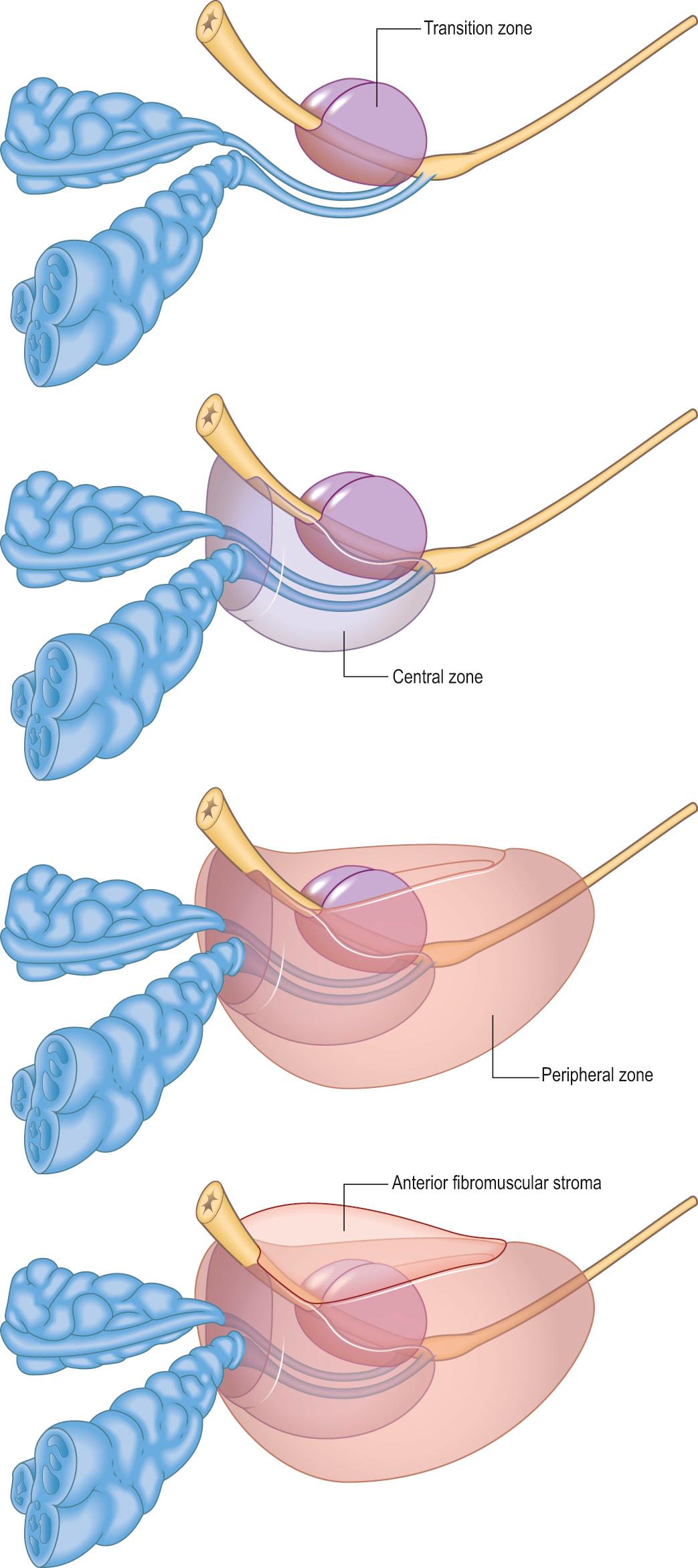
The peripheral zone ducts exit directly lateral from the posterolateral recesses of the urethral wall. The system consists of long, narrow ducts surrounded by a stroma of loose muscle bundles. This area is the principal site of carcinoma of the prostate and is not involved in BPH. Hence early prostate cancer usually causes no symptoms as it grows in the zone well away from the urethra.
The central zone ducts run predominantly proximally following the ejaculatory ducts. They are much larger and of irregular contour, and the muscular stroma is more compact than in the peripheral zone. The central zone has a low incidence of disease.
The transition zone surrounds the proximal segment of the urethra between the bladder and the verumontanum. The principal feature of this region is the internal urinary or preprostatic sphincter, a cylindrical sleeve of smooth muscle. Although it contributes only 5% of the volume in the normal prostate, the transition zone is the principal site of BPH ( Fig. 73.5 ). Nodular expansion of this region results in compression of the urethra and varying degrees of bladder outlet obstruction. As a result, voiding urinary symptoms are usually due to BPH expansion of the transition zone rather than prostate cancer.
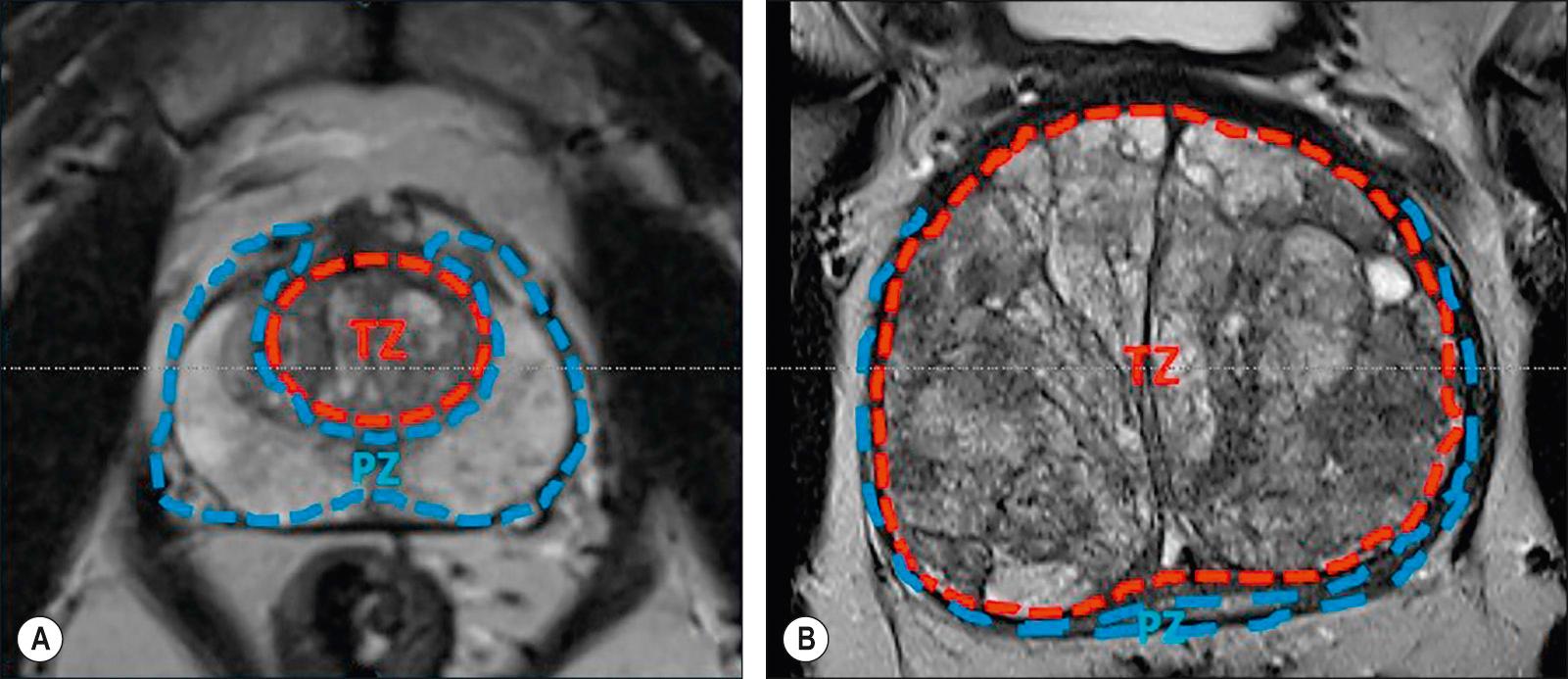
The arterial supply of the prostate is predominantly from the prostatic artery, a branch of the inferior vesical artery from the internal iliac artery, which enters the prostate from either side of the gland at the posterolateral aspect of the base. The prostatic artery divides into urethral and capsular groups of arteries. Additional arterial supply can be derived from the middle rectal and pudendal arteries.
The venous system forms the prostatic plexus (Santorini's plexus), which receives the deep dorsal vein of the penis and drains into the internal iliac vein. The communication between the internal iliac vein and the vertebral venous plexus is the proposed pathway for the propensity for axial skeletal metastases that are seen in prostate cancer.
Become a Clinical Tree membership for Full access and enjoy Unlimited articles
If you are a member. Log in here